Paper Money: A Short Gallery Tour

The design of a banknotes is, technical aspecta aside, a sort of art in-and-of-itself. Banknotes bear portraits of monarchs, or sometimes artists, or proudly display buildings or national artifacts that testify to the history of the issuing country. Sometimes a banknote, not in itself a painting, bears the reproduction of a painting. Banknotes can be small guides to the art galleries of the world. Here we offer a short virtual tour to some European galleries, using the money that has been and can still be found in our wallets as a guide.
Our trip starts in Vienna, Austria, which hosts the “Portrait of a Young Venetian Woman” painted in 1505 by Albrecht Duerer, and is now hosted by the Kunsthistorisches Museum. This painting can be found on the West German 5 mark note from between 1960 and 1990 (Federal German Republic P-18). This whole series bears imagery from paintings on the front side. The source for the portrait of the 500 mark note is in the same gallery, while for the rest of the series to be seen one has to travel to Kassel, Frankfurt, Berlin or Brussels. But now we depart for Italy ...
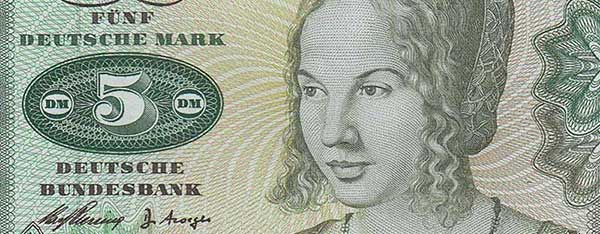
In Milan, and more specifically in Pinacoteca Ambrosiana, we can admire the work of Caravaggio, “The Basket of Fruit” from 1599. Its reproduction was shown before the introduction of the Euro on the back side of the 100000 lire note from the 1983 and 1994 series (Italy P-110 and Italy P-117, respectively). In the Pinacoteca a visitor can also see the sketches for the Raphaels “The School of Athens” from 1511, reproduced on the 500000 lire note of the same series (Italy P-118, but for the full sized fresco one would have to drive further to Rome, and more specifically to the Apostolic Palace of the Vatican City. Italian banknotes have presented several other paintings, but we hurriedly depart for Spain.
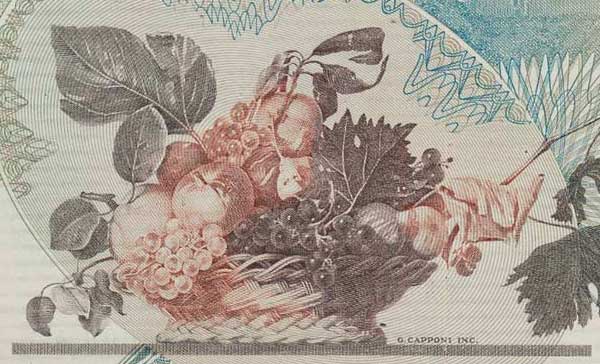

In Madrid in Museo del Prado we can see the oil on linen by Francisco Goya “The Parasol” from 1777. This painting was shown on the back side of the Spanish 100 peseta note (Span P-131). Spanish notes from between the 1920's and the 1960's contained on their back sides several reproductions of the paintings but never for a whole series. One has to admit that in comparison to the other European countries Spain has used painting on their paper money more often than other nations. For some shown paintings it would be otherwise impossible for them to be seen, as is the case for the “La Fuensanta” from 1929 – the portrait of an Andalusian woman by Juan Romero de Torres (Spain P-145). Currently this painting is in a private collection, an the last time it changed the owners (in 2007) it was at the expense of 1,173,400 Euros.
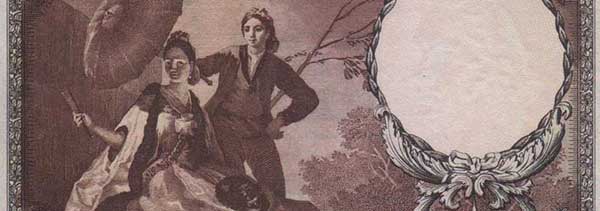
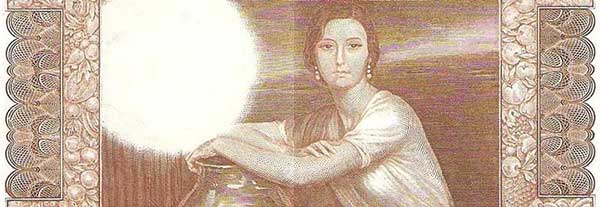
For the fans of still life art a visit to Musée de l'Orangerie in Paris, France is our next destination. Paul Cezanne’s “Apples and Biscuits” from 1880 hangs there. It was presented on the 100 French franc note from 1997 (France P-158). In the nearby Louvre one can no longer view Eugene Delacroix's painting “Liberty Leading the People” which was partially shown on the 100 French franc note (France P-153). To view this painting one would have to drive further to Lens, but it is time to take a rest.
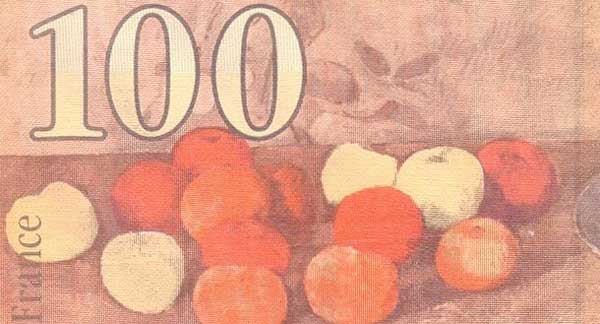

 Our virtual tour could end in everyones home library. We are not talking about a painting in the true sense, but rather an illustration from “The Little Prince” by Antoine de Saint-Exupery. On page 2 of the book the sketch “A Boa Constrictor Digesting an Elephant” is shown – representing the power of the imagination of a child and of a curious and open-minded person. Its reproduction was shown as security feature on the 50 French franc note P-157 of the same series as Cezanne’s painting (France P-157). For a curious person recognising the value of seeing such art and detail could lead to the start of a long friendship with the hobby of banknote collecting.
Our virtual tour could end in everyones home library. We are not talking about a painting in the true sense, but rather an illustration from “The Little Prince” by Antoine de Saint-Exupery. On page 2 of the book the sketch “A Boa Constrictor Digesting an Elephant” is shown – representing the power of the imagination of a child and of a curious and open-minded person. Its reproduction was shown as security feature on the 50 French franc note P-157 of the same series as Cezanne’s painting (France P-157). For a curious person recognising the value of seeing such art and detail could lead to the start of a long friendship with the hobby of banknote collecting.





